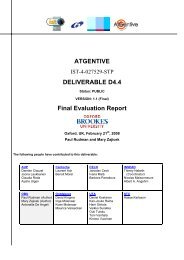pdf 820Kb - INSEAD CALT
pdf 820Kb - INSEAD CALT
pdf 820Kb - INSEAD CALT
Create successful ePaper yourself
Turn your PDF publications into a flip-book with our unique Google optimized e-Paper software.
Evaluation report of the use of Onto-Logging<br />
platform in the user site<br />
Deliverable ID: D8b<br />
Some other reasons were suggested bellow by the ontology engineer of Indra:<br />
Page : 56 of 110<br />
Version: 1.0<br />
Date: 27 january 2004<br />
Status: Final<br />
Confid.: Public<br />
One important problem of the ontology was located in some concepts. These concepts<br />
weren’t too clear to users, so they misused it, causing some chaos in the information. This<br />
problem was related with the terminology (proposed reason 3), because some of the<br />
problematic concepts weren’t used in daily work, and also related with consensus about<br />
concepts (proposed reason 4), because if a concept is not specific, each user will apply his or<br />
her own idea of the concept.<br />
For example:<br />
• Term and Topic were fuzzy concepts, so people tend to use it for everything they did not<br />
know where to put. Therefore the instances for these two concepts were totally<br />
heterogeneous because the name of the concept was too general, so each user had are own<br />
meaning.<br />
• Technology and its sub-concepts: some of these concepts refer to similar ideas (software,<br />
operating systems, commercial products), some of them were useless (requirements), or<br />
some were too general (services). The consequence of these problems was that nobody<br />
used these concepts and their instances homogeneously.<br />
In case of other concepts, the problem was with the nomenclature or formats: the format for<br />
dates, for numbers. For example, in the attribute duration of a project, the unit was not<br />
specified, so each user had its own idea about the format: using months, years, days, the<br />
initial and final date of the project.<br />
Therefore, a first conclusion may be that it is very important to use specific concepts, in order<br />
to avoid misunderstandings. Although the DUI includes the possibility of adding some kind<br />
of help to users (specifying the format and a brief tool-tip for each concept), it would be very<br />
interesting that it would be possible attaching a description to each concept of the ontology,<br />
making this description or help available in the DUI. This way, the users can always review<br />
the help for a concept in order to clarify their doubts without receiving a previous course<br />
about the ontology. For example: “The organizations related with an operation using the<br />
relationship -implies- can be clients, partners, providers…”<br />
Regarding the reasons 1, these were clearly present in the Documents concepts definition.<br />
This definition was very scarce, so it was difficult to distinguish the different types of<br />
documents involved in a proposal or in a project. Also the original ontology didn’t include<br />
the option to relate a Proposa l to the corresponding project (if the proposal is awarded).<br />
The ontology was also uncompleted in people definition, because there was only a concept<br />
for all the people. In the new ontology this has been addressed including three sub-concepts<br />
of the “People” concept.
















